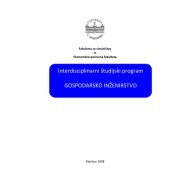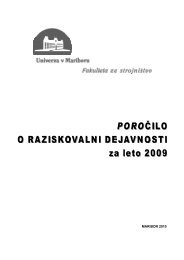University of Maribor version 01 22.4.2009 - Fakulteta za strojništvo ...
University of Maribor version 01 22.4.2009 - Fakulteta za strojništvo ...
University of Maribor version 01 22.4.2009 - Fakulteta za strojništvo ...
Create successful ePaper yourself
Turn your PDF publications into a flip-book with our unique Google optimized e-Paper software.
Information Package on the degree programmes <strong>of</strong> the Faculty <strong>of</strong> Mechanical Engineering <strong>Maribor</strong> Part TWO Page 46<br />
The optional courses <strong>of</strong> the module contain the procedures <strong>of</strong> finite and boundary elements by solving the Laplace and<br />
Poisson equation and other nonlinear problems <strong>of</strong> solids. Thermoplasticity includes thermoelastic relations, the law <strong>of</strong> plastic<br />
yield, viscoelasticity and viscoplastic materials. The mechanics <strong>of</strong> objects and processes deals with stability <strong>of</strong> time-dependent<br />
nonlinear vibrating systems, behavior <strong>of</strong> systems in the presence <strong>of</strong> disturbances, perturbation methods, the methods <strong>of</strong> harmonic<br />
balance, periodic and almost periodic vibrations and the construction <strong>of</strong> chaotic regions. Optimal design deals with the problems<br />
<strong>of</strong> mathematical programming, conventional optimi<strong>za</strong>tion, shape and topology optimal design and with the methods for solving the<br />
NLP problems. Nonlinear fracture mechanics contains fracture mechanical testing, model modifications, connection regions for<br />
quasistatic fracture, application on structures (CTOD and PD7910) and examples <strong>of</strong> fracture based construction. The theoretical<br />
part comprises the fundamentals required for solving problems <strong>of</strong> nonlinear mechanics which can not be solved by existing<br />
system s<strong>of</strong>tware. For practical research work s<strong>of</strong>tware like ABAQUS, FRANZ, LS-DYNA, I-.DEAS, NISA, FEMSITE, PATRAN,<br />
Pro/ENGINEER, Pro/COSMOS, Pro/NASTRAN, Pro/MECHANICA, Pro/ADAMS, etc., can be used.<br />
The lectures <strong>of</strong> the module Nonlinear mechanics are held by scientifically active pr<strong>of</strong>essors. The experimental work on the field<br />
<strong>of</strong> nonlinear fracture mechanics can be done in a contemporarily equipped laboratory <strong>of</strong> the Faculty <strong>of</strong> mechanical engineering<br />
(FME). The most demanding tests can be done on foreign institutes with which we are collaborating.<br />
Module courses<br />
FIRST YEAR<br />
A. The 3 compulsory courses <strong>of</strong> the module:<br />
� Mathematics (Selected Topics)<br />
� Physics (Selected Topics)<br />
� Mechanics (Selected Topics)<br />
SECOND YEAR<br />
B. Optional courses <strong>of</strong> the module:<br />
The student selects 3 subjects from the set <strong>of</strong> optional courses, at least two <strong>of</strong> them from group B1:<br />
B1. Optional courses <strong>of</strong> this module<br />
� Finite and boundary elements<br />
� Thermo-plasticity<br />
� Mechanics <strong>of</strong> objects and processes<br />
� Optimal design<br />
� Nonlinear fracture mechanics<br />
� Structural integrity<br />
� Computational fluid dynamics<br />
� Fluid dynamics in turbo machinery<br />
� Statistical thermodynamics<br />
� Rheology<br />
B2. Optional courses from other modules, study courses and faculties<br />
� optional courses from other modules <strong>of</strong>fered on the FME.<br />
� optional courses <strong>of</strong>fered on any postgraduate study direction on FME.<br />
� optional courses <strong>of</strong>fered on postgraduate study <strong>of</strong> other faculties <strong>of</strong> <strong>University</strong> <strong>of</strong> <strong>Maribor</strong> or other universities<br />
INTELLIGENT TEXTILES<br />
Advanced intelligent textile materials are based on the development <strong>of</strong> new technologies, such as genetic engineering,<br />
biotechnology, nanotechnology, microelectronics and information technology. These materials are characterised by high<br />
functionality resulting from the use <strong>of</strong> special fibres which can be physically or chemically modified. Intelligent textiles are able to<br />
sense stimuli from the environment (temperature, mechanical or chemical influences, light changes, changes in the concentration<br />
<strong>of</strong> electrolytes, etc.) and to react and adapt to them. They are thermoregulative, electroconductive, self-cleaning, bioactive, IR<br />
<strong>University</strong> <strong>of</strong> <strong>Maribor</strong> <strong>version</strong> <strong>01</strong> <strong>22.4.2009</strong>





